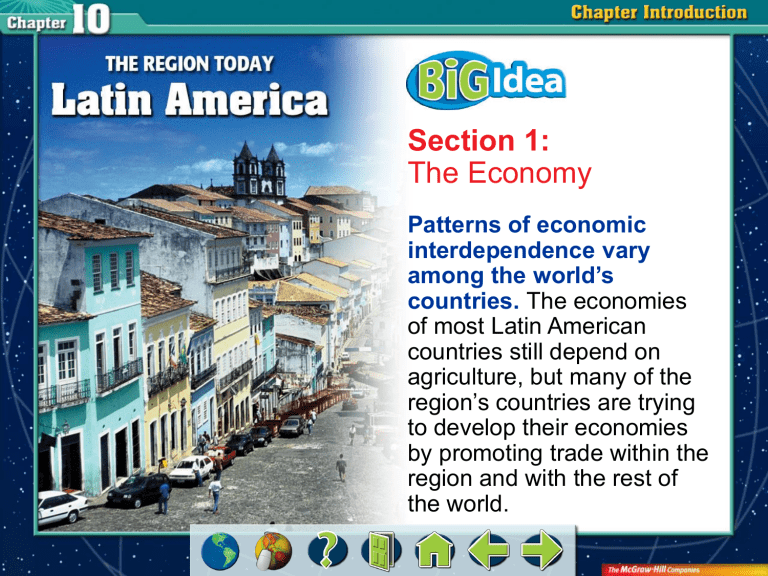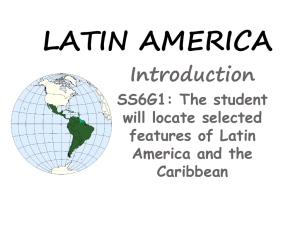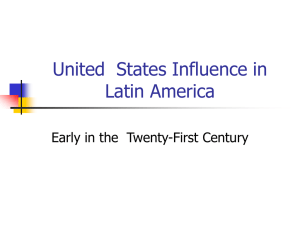Section 2

Section 1:
The Economy
Patterns of economic interdependence vary among the world’s countries.
The economies of most Latin American countries still depend on agriculture, but many of the region’s countries are trying to develop their economies by promoting trade within the region and with the rest of the world.
Chapter Intro 2
Section 2: People and
Their Environment
Changes occur in the use, distribution, and importance of natural resources.
Rapidly increasing human populations and consumer demand for natural resources place tremendous stress on these resources and pose serious challenges for the preservation of rain forests in
Latin America.
Chapter Intro 3
The Economy
Latin America has promoted economic development through trade within the region and with the rest of the world.
Section 1-GTR
Economic Activities
Latin America’s economic development has been affected by many factors, including physical geography.
• Latin America struggles with:
– Unevenly distributed farmland between a small group of wealthy landowners and a much larger group of campesinos
Share in Total Latin American Exports, 2005
Section 1
Economic Activities
(cont.)
– Economic inequality
– Dependence upon export products, such as bananas, sugarcane, and coffee
– Industrial growth, which is limited by physical features such as the Andes
Economic Activity in Latin America
Section 1
Economic Activities
(cont.)
• Positive factors in Latin America:
– Suitable region for growing cash crops
– Many developing countries
– Service industries are diversifying.
Section 1
Transportation and Communications
Latin American countries are working to improve transportation and communications systems necessary for economic development.
• Latin America’s physical geography affects transportation and communications.
• Transportation—roads and railroads must often cross many physical barriers.
Section 1
Transportation and Communications
(cont.)
• The Pan-American highway is a good road system, however.
• Some countries have well-developed rail systems.
• Inland waterways are very important.
• Air travel will help as it becomes more affordable.
Transportation Networks
Section 1
Transportation and Communications
(cont.)
• Communications—Latin America’s communications networks include newspapers, radio, and television, but are often censored by governments during political unrest.
• Internet use is expected to grow rapidly.
Section 1
Trade and Interdependence
Many Latin American countries developed their economies by promoting trade and decreasing foreign debts.
• NAFTA (North American Free Trade Agreement)— trade among Mexico, the U.S., and Canada increased 10 –15% annually after the agreement was implemented, but the agreement has been controversial in general.
Section 1
Trade and Interdependence
(cont.)
• CAFTA (Central American Free Trade
Agreement) —the U.S. and six Central American countries signed this agreement into law in 2005, hoping to lower trade barriers.
• Many Latin American countries are still repaying the debt to foreign banks from funds borrowed in the ‘60s and ‘70s, which is hindering needed domestic programs.
Mexican Exports to the United States
Section 1
People and Their Environment
This section discusses the importance of natural resources in Latin America and the challenges the region faces in preserving these resources as human populations, urbanization, and industrialization continue to increase.
Section 2-GTR
Managing Resources
Latin America is working to protect the environment while facing rapid urbanization and growing human needs.
• The rain forests in Latin America are disappearing as a result of deforestation.
Section 2
Managing Resources
(cont.)
• The land is being used for:
– Farming
– Ranching
– Timber and other products
Section 2
Managing Resources
(cont.)
• The destruction of rainforests leads to the loss of:
– Biologically rich ecosystems/biodiversity.
– Key medicines and treatments for cancer and other diseases.
– Carbon dioxide in the atmosphere.
Section 2
Managing Resources
(cont.)
• Helpful actions:
– New methods of farming, mining, and logging
– Conservation
– Responsible tourism
– Reforestation
Section 2
Human Impact
Rapid urbanization and industrial growth have placed tremendous stress on available natural resources in Latin America.
• Problems due to rapid urbanization:
– Insufficient jobs or housing for many people
– Natural disasters can wipe out entire communities.
Section 2
Human Impact
(cont.)
– Unsanitary areas and the spread of disease
– Air pollution
Section 2
Human Impact
(cont.)
• Problems due to industrial growth:
– Air and water pollution
Urban Growth in Latin America
Section 2
Future Challenges
Latin America faces many international challenges, including conflicts over natural resources and preparing for natural disasters.
• During the past 150 years, Latin America has faced a number of territorial conflicts over strategic locations or rights to valuable natural resources.
Section 2
Future Challenges
(cont.)
• Latin American governments are cooperating in order to forecast:
– Hurricanes
– Volcanic eruptions
Border Conflicts and Natural Resources
Section 2
An Open Economy
• Latin America has gradually opened up its economy to outside investment from businesses and countries around the world.
• Through the NAFTA and CAFTA trade agreements, barriers to trade have been reduced in
Mexico and Central America.
• Although opening the market has brought in many jobs, critics say many of those jobs are dangerous.
• Many Latin American countries have also accepted loans that they are unable to repay, causing their economies to stagnate.
VS 1
Population Pressures
VS 2
Figure 1
Figure 2
Figure 3
Figure 4
Figure 5
Figure 6









